 As we mentioned in our math strategy article on plugging in answers, neither the SAT nor the ACT measures how you arrived at your answer. On standardized tests, all that matters is whether your answer is correct or not. There is no such thing as partial credit on a standardized test and no one is looking over your shoulder to see if you solved the question the “proper” way.
As we mentioned in our math strategy article on plugging in answers, neither the SAT nor the ACT measures how you arrived at your answer. On standardized tests, all that matters is whether your answer is correct or not. There is no such thing as partial credit on a standardized test and no one is looking over your shoulder to see if you solved the question the “proper” way.
This means that finding the right answer--no matter the process--is the only thing that matters. And there are plenty of short-cut techniques you can use to find that correct answer without the need to create and solve complex equations. This guide will take you through the strategy of plugging in your own numbers, one of simplest processes for working out the answers to several different kinds of standardized math questions.
In this guide, we’ll give you a complete walk through on the strategy of plugging your own numbers (PIN) for math questions. We’ll go through the whys, hows, and, most importantly, whens of using PIN your standardized test(s), as well as take you through several real SAT and ACT practice problems. The other best strategy for working around problems--plugging in the answers--is covered in a separate guide.
Why Use Plugging in Numbers?
Sometimes you may find yourself confronted with a problem that you have no idea how to approach. Sometimes you may just think it will take too long to solve the problem algebraically. And other times, you may be given so many different variables in a single problem that you want to make absolutely sure you have the correct solution. When this happens, plugging in your own numbers can often help get you to the right answer.
It can be intimidating to be given a question or answer choices with multiple variables, especially when you are on a strict time crunch. But if you use real numbers in place of x or y or a or k (or any other variable), it can make a previously obscure problem turn into one that it quite simple. Using numbers in place of variables can make the more theoretical questions become more practical and easy to visualize, which will allow you to solve them much more easily.
For example,
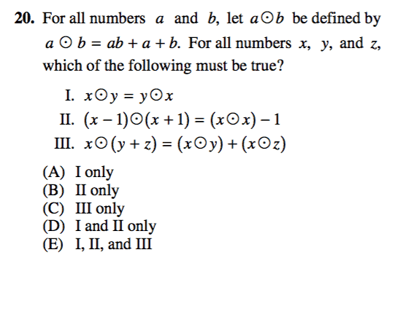
(We'll walk through how to solve this question in the next section)
It can be very easy to forget that you have the power to replace variables with your own numbers while you’re taking the test. So remember to relax and know that solving a question via complex algebra is not your only option; you have other avenues available that are often much easier to work with.

How to Use Plugging in Numbers
So now that you know why plugging in numbers can come in handy, let’s go through exactly how to do it.
The basic idea of plugging in your own numbers is that you provide real numbers in place of variables or unknowns in your problem. This technique can work for any problem--algebra or geometry--in which you are presented with several unknowns, or variables.
The best way to tell if you can use PIN on a question is to look and see if the question, the answer choices, or both involve variables. When the question and/or answer options include variables (especially multiple variables), you can most likely use PIN.
Because these kinds of questions are asking about the relationships between numbers (or objects or degrees, etc.), these relationships will be constant, no matter what actual numbers are used. As long as your numbers follow the rules you are presented with in the question, then you can find the right answer using your own numbers.
Then, once you’ve picked a number to represent a variable, use that number to solve the original equation. Then use the number you chose for your original variable to replace that same variable in your answer options. By doing this, you can test your answer options and see which answer choices match the result you got for your original equation when you plugged in your own numbers.
Don’t worry if this doesn’t make any sense to you yet. We’ll break down the steps using an actual math problem example:
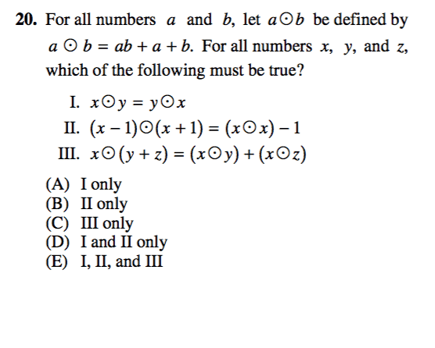
We are told that the mathematical relationships described above work for all numbers $x, y, & z$. This means we are allowed to pick any numbers we would like for $x, y, & z$ because any and all numbers must work.
We have multiple variables and a complex series of equations. Let's make life easier on ourselves and give each of these variables a number. Let's say that:
$x = 2$
$y = 3$
$z = 4$
Now, let's solve our problems in accordance with the rules we were given and see if the equations are equal.
The first is:
$x ⊕ y = y ⊕ x$
Let's take the left half of the equation first and replace our variables with numbers.
$x ⊕ y$
$2 ⊕ 3$
Well, according to our rules, this would be:
$2 ⊕ 3 = (2)(3) + 2 + 3$
$11$
The left half of our equation is 11. Now let's look at the right half to see if it is equal.
$y ⊕ x$
$3 ⊕ 2 = (2)(3) + 3 + 2$
$11$
Both sides equal 11, so option I is correct. This means we can eliminate answer choices B and C.
Now let's try the equation for option II, using our same numbers for our variables.
$(x - 1) ⊕ (x + 1) = (x ⊕ x) - 1$
Again, let's take the left side of the equation first.
$(x -1) ⊕ (x + 1)$
$(2 - 1) ⊕ (2 + 1)$
$1 ⊕ 3$
$1 ⊕ 3 = (1)(3) + 1 + 3$
$7$
So the first half of the equation equals 7. Now let's see if the right half is equal.
$(x ⊕ x) - 1$
$(2 ⊕ 2) - 1 = ((2)(2) + 2 + 2) - 1$
$7$
Both sides equal 7, so option II is correct. We can eliminate answer choice A.
Finally, let's test the last equation.
$x ⊕ (y + z) = (x ⊕ y) + (x ⊕ z)$
Looking at the left side of the equation, we have:
$2 ⊕ (3 + 4)$
$2 ⊕ 7$
$2 ⊕ 7 = (2)(7) + 2 + 7$
$23$
The left side of the equation equals 23. Now let's test the right to see if it matches.
$(x ⊕ y) + (x ⊕ z)$
$(2 ⊕ 3) = (2)(3) + 2 + 3$
$11$
And
$2 ⊕ 4 = (2)(4) + 2 + 4$
$14$
We are told to add the two together, which gets us:
$11 + 14 = 25$
The left half of our equation was 23 and the right half was 25. The two expressions not equal, so option III is incorrect.
This means our final answer is D, I and II are the only correct equations for all values of $x, y, & z$.
Again, we were able to choose all of our own numbers for this problem, but this will not universally be the case.
Always pay attention to when you have the leeway to choose your own numbers for multiple (or all) variables, and when you must choose a number for only one variable and solve for the rest. The reason we were allowed to choose numbers for every variable above was because the problem told us the equations were true for all numbers. This meant that any numbers we chose followed the rules as outlined by the problem.
You will be able to tell when you can plug in numbers for multiple variables because the problem will specifically tell you that "all numbers" or "all integers" must work in place of your variables. This gives you free reign to pick your numbers with impunity. If you don't see the words "all numbers" or "all integers" in the question, then you may only use your own number for one variable and solve for the rest. This will keep the variables following their defined rules and keep the relationships between them intact.
Now let's look at a problem where we CANNOT pick our own numbers for every variable:
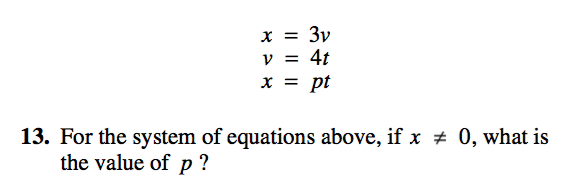 Because we are not told that this problem works for "all numbers," we know we must choose our own number for just one variable and solve for the rest.
Because we are not told that this problem works for "all numbers," we know we must choose our own number for just one variable and solve for the rest.
In this problem, I've chosen to replace $v$ with my own number. Why $v$? Because $v$ shows up in the middle equation and so will be useful for finding our other variables.
We can also see that $v = 4t$, so let's give $v$ a number that is divisible by 4. (Note: we do not HAVE to make $v$ divisible by 4, but it makes life easier for us, as it means we will be dealing with integers rather than decimals.)
So let's just say that $v = 8$. If we replace every $v$ with the number 8, our first equation would look like:
$x = 3v$
$x = 3(8)$
$x = 24$
So we know now that, when $v = 8$, $x = 24$. Now for our second equation:
$v = 4t$
$8 = 4t$
$t = 2$
So, when $x = 24$ and $v = 8$, $t$ will be 2.
And finally, let's look at the last equation using our newly found numbers for $x$ and $t$.
$x = pt$
$24 = p(2)$
$p = 12$
So $p$ equals 12.
But wait! Maybe you think $p$ equals 12 only in this this one instance and that it would equal something else had we chosen a different number for $v$. Well let's test it.
Let's say that $v = 20$ instead of 8.
$x = 3v$
$x = 3(20)$
$x = 60$
And our second equation:
$v = 4t$
$20 = 4t$
$t = 5$
And finally, our last equation:
$x = pt$
$60 = p(5)$
$p = 12$
As you can see, no matter what value we choose for one of our variables, $p$ will always equal 12 as long as we keep the relationships between the variables intact.
So our final answer is 12, $p = 12$
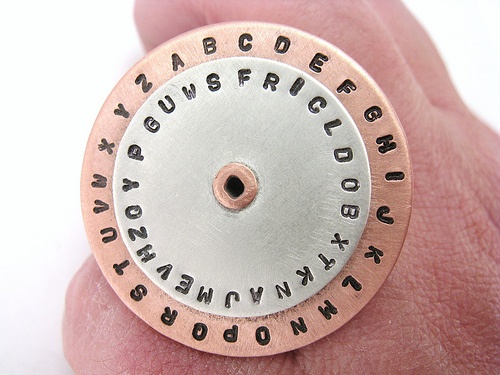
Using PIN can be like having your own personal decoder ring.
Tips and Tricks for PIN
Now that you know how PIN works, you can use it more quickly and accurately by using these tips for your ACT and SAT math questions:
Tip 1) When using PIN, your best bet is to test each and every answer choice, even after one of the answers matches the one you got for your original equation.
Why should we do this? Because sometimes when we choose our own numbers, we can get multiple answer options that work.
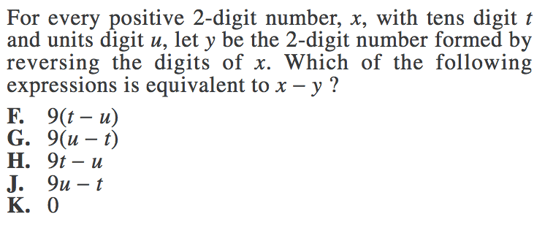
Let's say for this problem that you randomly chose 95 to be your two digit number for $x$. If:
$x = 95$, then the tens digit $t = 9$, and the units digit $u = 5$.
We are told that $y$ is the number found by reversing the digits, so when $x = 95$, $y = 59$.
And finally, we are searching for the value of $x -y$. Using our numbers:
$x - y = 95 - 59$
$x - y = 36$
Now let us test our answer options using the numbers we have found for our variables and see which one matches 36.
F. $9(t - u)$
$9(9 - 5)$
$9(4)$
$36$
Answer F works! (We can also eliminate answer choice K right now, because $36 ≠ 0$).
G. $9(u - t)$
$9(5 - 9)$
$9(-4)$
$-36$
Answer G has been eliminated.
H. $9t - u$
$9(9) - 5$
$81 - 5$
$76$
Answer choice H has been eliminated.
J. $9u - t$
$9(5) - 9$
$45 - 9$
$36$
Uh-oh! We found 36 for both F and J.
When this happens, we must choose a different number or set of numbers in order to eliminate the answer that only works sometimes. Our goal is to find the answer that works always and no matter what.
But now that we have chosen a different set of numbers, do we have to test each answer choice again? Nope! We already know that G, H and K didn’t work last time, so they won’t be our final answer. Again, we are looking for the answer that works every time. Only test F and J again.
Instead of $x = 95$, let's say that $x = 43$ (Again, this number is entirely random and can be anything you'd like).
If $x = 43$, then $t = 4$ and $u = 3$. It also means that $y$, as the reverse of $x$, will be 34.
$x - y = 43 - 34$
$x - y = 9$
So now we are looking for the answer choices that match 9. So let us once more test F and J.
F. $9(t - u)$
$9(4 - 3)$
$9(1)$
$9$
Looking pretty good for answer choice F. But let's look at J as well.
J. $9u - t$
$9(3) - 4$
$27 - 4$
$23$
Success! We can eliminate answer choice J now and feel confident that F (and only F) will work no matter our values for $x$ and $y$.
So our final answer is F, $9(t - u)$
Tip 2) When plugging in your own numbers, avoid using the numbers 1 or 0.
It can be very easy to get multiple right answers or very screwy answers when using 1 or 0, so it is best to avoid them.
For example, let's look again at the first problem we saw:

Now let's say that we had said $x = 0$, $y = 1$, and $z = 2$. For the sake of saving time, the first two equations are still correct, but now let's look at the third.
$x ⊕ (y + z) = (x ⊕ y) + (x ⊕ z)$
First, let's look at the left half of the equation:
$x ⊕ (y + z)$
$0 ⊕ (1 + 2)$
$0 ⊕ 3$
$0 ⊕ 3= (0)(3) + 0 + 3$
$3$
Now let's look at the right half of the equation:
$(x ⊕ y) + (x ⊕ z)$
$(x ⊕ y)$
$0 ⊕ 1 = (0)(1) + 0 + 1$
$1$
And
$(x ⊕ z)$
$0 ⊕ 2 = (0)(2) + 0 + 2$
$2$
So when we add them together, we get:
$1 + 2 = 3$
This means that both sides of the equation are equal, which would mean that I, II, AND III were all correct. And we already proved when we did this question earlier that III is actually incorrect. (Remember, the answer choices must work every single time.)
If we had used 0 and/or 1 in place of our variables, we would have gotten the question wrong. We would have chosen answer E, when really answer D is correct.
Tip 3) Good numbers to use when working with percentages are 100 or 10, as most percentages questions involve you having to manipulate them around.
Using nice, round numbers can make life easy for you.
Alice has been collecting sea shells for many years. From 2009 to 2010, she increased her collection by 30%. From 2010 to 2012, she added another 20% to her collection. But in 2014, she had to move away and get rid of 50% of her collection. What percentage of her original shell collection did Alice end up with?
- 75
- 78
- 100
- 150
- 156
Let's say, for the sake of a nice round number and a good one to use with percentages, that Alice started out with 100 shells.
If she increased her collection by 30% from 2009 to 2010, then she would have $100 + 100(0.3) = 130$ shells in 2010.
If she then increased her collection by another 20% from 2010 to 2012, she woud have $130 + 130(0.2) = 156$ shells in 2012.
Now, she must get rid of 50% (half) of her shells.
$156 - 156(0.5) = 78$
So she is left with 78 shells. And, since we used 100 for her original amount, we do not have to fiddle with finding percentages. We can simply see that she is left with 78% of her original collection.
So our final answer is B, 78.
 One day Alice may feel that she has enough sea shells. Today is not that day.
One day Alice may feel that she has enough sea shells. Today is not that day.
When to Use Plugging in Numbers
Because it is best to test out each answer option when using PIN, it can often take longer to solve a question this way than by using algebra alone. Sometimes you can check all the answers at a glance, which will save time, but whether or not using PIN will eat up more time than it saves truly depends on the question
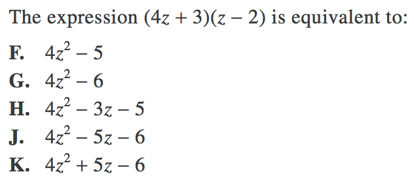
This question would be a slow PIN. If you don't remember how to FOIL and you are fuzzy on your rules for multiplying and subtracting integers and variables, then go ahead and use PIN here.
But if you are at all comfortable with the above mathematical concepts, then simply work with your variables and save using PIN for another occasion.
As a demonstration, see how fast it is to use algebra here:
$(4z + 3)(z - 2)$
$(4z *z) + (4z * -2) + (3 * z) + (3 * -2)$
$4z^2 - 8z + 3z - 6$
$4z^2 - 5z - 6$
So your answer is J.
On the other hand, look how slow the process is using PIN:
Let's say our $z$ value is 4.
$(4z + 3)(z - 2)$
$(4(4) + 3)(4 - 2)$
$(19)(2)$
$38$
So we are looking for an answer choice that matches 38.
F. $4z^2 - 5$
$4(4^2) - 5$
$64 - 5$
$59$
Option F is too large, so we can eliminate it. We can also eliminate option G because we can see that it would be 58, which is still too large.
H. $4z^2 - 3z - 5$
$4(4^2) - 3(4) - 5$
$64 - 12 - 5$
$47$
We can eliminate option H, as it is still too large.
J. $4z^2 - 5z - 6$
$4(4^2) - 5(4) - 6$
$64 - 20 - 6$
$38$
We have found an answer that matches our original equation. This could be our right answer, but let's look at option K to make sure we don't have duplicate correct answers.
At a glance, we can tell that option K ($4z^2 + 5z - 6$) would be too large, because we would be adding 20 to 64. This means we can comfortably eliminate it.
So our final answer is J.
Though we were still able to find our answer, it took noticeably longer using PIN.
Basically, don't be afraid to use PIN to help you through a test, but make sure you use it in places that will help you the most and get you to the right answer in the shortest amount of time.
Now let's look at a quick PIN problem.

This is a problem you can mostly do in your head using PIN. For example, give $a$ and $b$ small numbers and then you can work out your answer choices fairly quickly.
Let's say that $a = 2$ and $b = 3$. Using those numbers, we know then that the absolute value of $a - b = 1$. Why? Because $a - b$ => $2 - 3 = -1$ and absolute values make anything contained in them positive. (For more info on this, check out our guides to advanced integers on the ACT and SAT)
So we can tell straight away that F is incorrect, as that would be 5. This means G is also incorrect, as it would be -5.
H would be an imaginary number, as it is the square root of a negative.
J would be a negative number.
Only K makes sense and we can see for ourselves that it is correct. $-(2 - 3) = +1$, which is the answer we are looking for.
So our final answer is K.
See how we were able to solve the second question noticeably faster using PIN? As you do more and more ACT and SAT math practice problems, you'll better be able to intuit when to use PIN (and when to use algebra or skip the question entirely) as you go through your test.
As a general rule, if you have a lot of spare time per section, then go ahead and use PIN! It may even save you time going back and double-checking your work (though it never hurts to be extra sure and double-check anyway).
If, however, you find yourself running short on time, you may want to save using PIN for these circumstances only:
1) You cannot find a way to solve the problem without using PIN
If you have absolutely no idea how to approach a problem, definitely use PIN! If you forget a math rule or equation, you can still find the answer with PIN. Often, you won’t have to know the rules for manipulating multiple variables or the rules for exponents, etc., if you can circumvent the question entirely by going straight to using your own numbers.
2) You have enough spare time that you can spend the extra using PIN
If you’ve gone quickly and accurately enough through earlier sections, go ahead and let yourself have the extra seconds per question that PIN uses. Though the difference between an algebraic solve and a PIN solve may not be more than 30 or 40 seconds, that time can add up fast. Always be sure you are using your time to your best advantage to get the most points possible across the board.
If you feel you are completely running short on time, however, check out our articles on how to buy yourself extra time on both the SAT and the ACT.
3) You want to double-check your answer
PIN can often act as its own question double-checker. This can sometimes help off-set the extra time PIN eats up, but don’t always count on this.
Because you found the answer by testing it out using real numbers instead of variables, you don’t have to plug more numbers into the equation to make sure it works--you already know it works! You’ve both solved your question and double-checked to make sure it was accurate all in one.
4) You feel that you may have found the wrong answer using algebraic methods
Maybe you started in on the question right away with algebra and got halfway through before you felt that you had taken a wrong turn somewhere. Maybe you know you tend to get distributing questions or exponent questions wrong. Maybe the algebra equation you set up spit out an answer that didn’t come close to any that were provided (or worse--maybe the answer you found was just slightly off).
If questions with multiple variables tend to trip you up, this means it’s probably a good idea to switch your method and try using PIN.
5) The question lies in a question range in which you have previously made several errors
If you have taken a practice SAT or ACT and discovered that you generally start to make mistakes around the halfway or three-quarter mark, switch your tactics to PIN instead of algebraic methods in this section in order to increase your score.
It can be slower, but it will be more accurate and you won’t have to spend as much time double-checking your work.
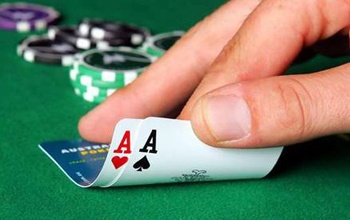 The more practice you get using PIN, the more you'll know when to hold 'em (and use PIN) and when to walk away.
The more practice you get using PIN, the more you'll know when to hold 'em (and use PIN) and when to walk away.
Can I Always Use Plugging in Numbers?
Unfortunately some questions can NOT be solved by plugging in answers. Again, when the question and/or answer options include variables, you can often use PIN.
If, however, your answers use numbers--integers, decimals, or fractions--your best bet is probably to use the strategy of plugging in answers.
Most questions (though not all) can be solved using one of these two strategies. To demonstrate the broad range of question types that both PIA and PIN can cover, let us look real SAT and ACT math questions and how to solve them using PIA and PIN.
Test Your Knowledge:
1) 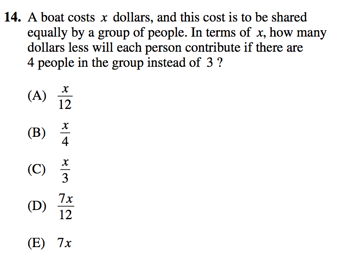
2) 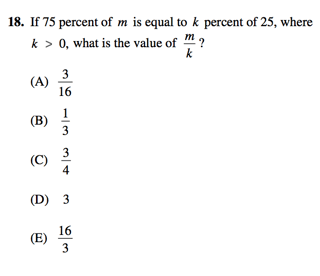
3) 
4)
5) 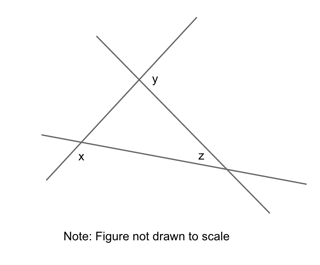 In the figure above, $z = 50$. What is the value of $x + y$?
In the figure above, $z = 50$. What is the value of $x + y$?
- 90
- 130
- 180
- 210
- 230
Answers: A, B, D, E
Answer Explanations:
1) In this first problem, we are dealing with the cost a boat for $x$ amount of dollars split first 3 ways and then 4. To make life easier on ourselves, let's pick a number for $x$ that is divisible by both 3 and 4, so that we do not have to work with decimals.
So let's say that the cost of buying a boat ($x$) is 120 dollars. Now, we are asked how much less it is per person to divide the cost by 4 instead of by 3. So let us divide 120 by both and find the difference.
$120/3 = 40$
$120/4 = 30$
$40 - 30 = 10$
So, when the boat costs 120 dollars, each member of the group will pay 10 dollars less when the cost is split 4 ways instead of 3 ways. Now let us test our answer options to see which one matches 10 dollars.
A. $x/12$
$120/12 = 10$
Answer A matches the answer we got. But before we celebrate, let us look over the other answer options to make sure there are no duplicate right answers.
Options B and C would be too large. If our number for $x$ divided by 12 was perfect, then that same number divided by 3 or 4 would be much larger.
Option E would also be enormous and far greater than 10 (as it is $x$ multiplied by 7), so that is out as well.
We can also and finally eliminate option D. We found our correct answer simply by dividing our $x$ value by 12. If we multiplied and then divided, that number would be much larger.
So our final answer is A, $x/12$
2) We need to find 75% of $m$ and $k$ percent of 25 (which we are told are equal). Instead of using decimals and fractions (and potentially getting ourselves confused), let us assign a number for $k$.
If we say, as a random choice, that $k = 60$, then we are finding 60% of 25.
$25 * 0.6 = 15$
And we know that this number (15) is 75% of $m$. So, to find $m$, we would say:
${15 * 100}/75 = 20$
So we have:
$k = 60$
$m = 20$
Now, we are asked to find $m/k$
$20/60 = 1/3$
So our final answer is B, $1/3$
3) Here, we need to know the difference between $t$ and $t^2$. So let us say that $t = 3$. (Why didn't we use 2 for $t$? Because, occasionally, using 2 for questions about squares and roots can give us duplicate right answers. For now, we are using 3 to reduce the possibility of needing to start over and select a different number, but we will look over what would have happened had we used 2 at the end of the problem.)
So, if $t = 3$, then $t^2 = 9$
The difference, then, between $t$ and $t^2$:
$9 - 3 = 6$
So we are looking for an answer option that matches 6.
Answers A, B, and C are all eliminated for being too small (answer C $= t = 3$).
Answer D is $t(t - 1)$
$3(3 - 1)$
$3(2)$
$6$
Answer D is correct, but let's look at answer E to make sure D is our only correct answer. Answer E is $(t - 1)(t + 1)$
$(3 - 1)(3 + 1)$
$(2)(4)$
$8$
This does not match, which means D is our only possible correct answer.
So our final answer is D, $t(t - 1)$
(But what would have happened if we had used $t = 2$ instead of $t = 3$? Well $t^2 = 2^2 = 4$ and the difference between $t^2$ and $t$ would have been $4 - 2 = 2$. So answers B, C, and D would have all been correct. When this happens, simply choose a different number, like $t = 3$ and test B, C, and D again.)
4) PIN can be used for both straight algebra problems and for geometry problems. As long as the numbers we choose follow the rules of geometry, then we should always get the right answer.
So here we have a triangle and we know one angle measure ($z = 50$). So let us give a value for each of the other angles inside the triangle.
If $z = 50$, then the other two angles have to add up to $180 - 50 = 130$. So let's call the angle next to $x$ 100, and the angle next to $y$ 30.
If the angle next to $x$ is 100, and it creates a straight line with $x$, then $x = 180 - 100 = 80$
And if the angle next to $y$ is 30 and it creates a straight line with $y$, then $y = 180 - 30 = 150$
$x = 80$ and $y = 150$
Together, they equal:
$80 + 150 = 230$
So our final answer is E, 230.

The Take-Aways
The strategy of plugging in your own numbers can be invaluable if you find yourself confronted with a problem you don’t know how to solve algebraically, or if you want to make absolutely sure you have the correct answer. The drawback, however, is that PIN can eat up extra time.
If you make sure to use your plugging-in strategies wisely and save them for times in which you need them most, you will likely find yourself solving problems you were never able to before.
What’s Next?
Now that you’ve gone through the ins and outs of PIN, make sure you know the other techniques for navigating standardized math questions. Be sure to check out our article on plugging in answers (PIA) to get a complete picture for how to circumvent using complex algebra on the SAT and ACT.
Running out of time on ACT or SAT math? Look no further than how to buy time on SAT math and how to buy time on ACT math.
Want to get a perfect score? Check out our article on how to get an 800 on the SAT math section and how to get a 36 on the ACT math section, both written by a perfect scorer.
Want to improve your SAT score by 160 points or your ACT score by 4 points? We've written a guide for each test about the top 5 strategies you must be using to have a shot at improving your score. Download it for free now:
Have friends who also need help with test prep? Share this article!

Courtney scored in the 99th percentile on the SAT in high school and went on to graduate from Stanford University with a degree in Cultural and Social Anthropology. She is passionate about bringing education and the tools to succeed to students from all backgrounds and walks of life, as she believes open education is one of the great societal equalizers. She has years of tutoring experience and writes creative works in her free time.



































 Holly R.
Holly R.